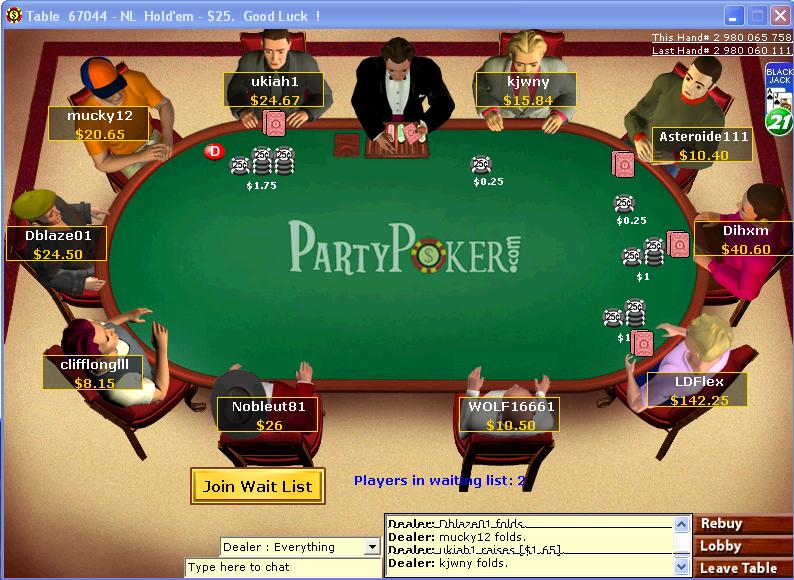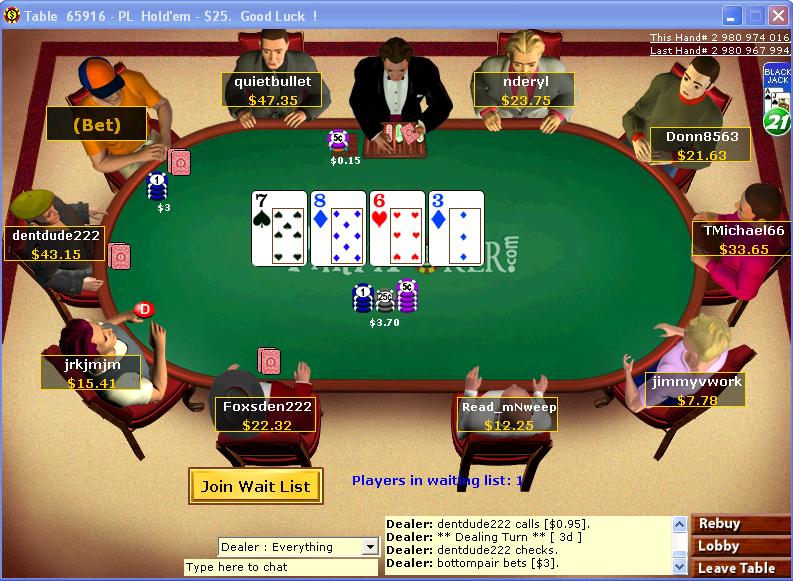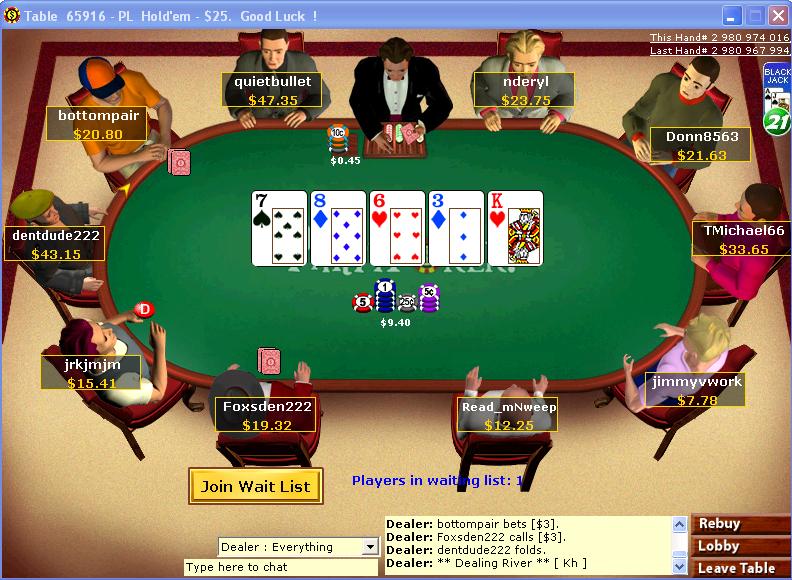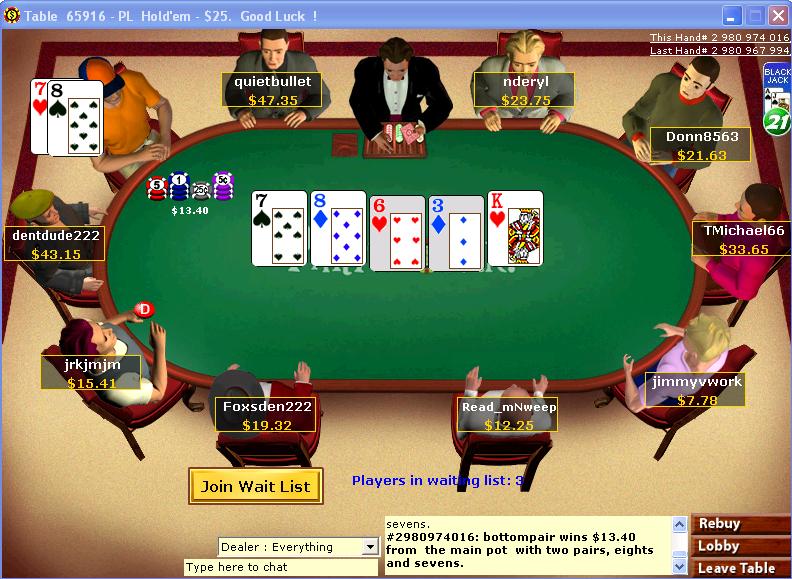|
|
Texas Hold'em Basics And Rules
Texas Hold'Em ("HE"), also called the "Las Vegas", is probably, among all poker variants, the one whose rules are the easiest to learn. But, as you will understand when you have some experience under your belt, it's not that easy to discover the refinements of this elaborate game.
With 2 hole cards (dealt face down to you, only you can see and use them) and 5 community cards (dealt face up at the middle of the table, anybody can see and use them) you will have to make the best five cards poker hand. You can use your 2 hole cards + 3 community cards or only one of your hole cards + 4 community cards or the five comunity cards (if you do so, any player will at least have an equal hand to you).
Your two hole cards are dealt at the beginning of the hand whereas community cards are revealed gradually (1 round of betting then 3 community cards, another round of betting then 1 community card, another round of betting then the last community card, a fourth and final round of betting and finally the showdown for players who still are in the hand).
Distribution of hole cards, posting of blinds:
=>you first have to decide who will deal the first hand of the poker session (usually, dealer and seats distribution are determined at the same time). For instance every player draws a card. Highest card (Ace>King>...>2 and Spades>Hearts>Diamonds>Clubs) chooses its seat and will be dealer for the first hand. Second highest card is right to the dealer and so on until the lowest card who will then be left to the dealer.
=>first player to the left of the dealer is the small blind, second is the big blind. Blinds are forced bets that these two players must wager, no matter if they intend to play or not with the two cards they've been dealt. The big blind can't be smaller than the small blind (usually twice the small blind).
=>dealer gives two cards to every player, one card at a time, starting from the small blind and ending with himself (clockwise). These 2 cards (the hole cards) are dealt face down and hence can only be seen by the player they've been dealt to.
=>once hole cards are dealt, a first betting round starts

On this picture (screen capture from an online pokerroom), the dealer is spotted by the button (the red disk placed on BufordDalt's left).
The button is also used in brick and mortar casinos. After every hand, the button is moved one seat left (clockwise). Here BufordDalt is the dealer. The software/professional dealer will deal for him but the button reminds who the blinds are . On every street, BufordDalt will be the last "free" player to act (=free to bet something or not, unlike the blinds). Dblaze post a 0.10$ small blind, Link27 posts a 0.25$ big blind. After this hand, the button will be on Dblaze01's left, Link27 and ukiah1 will be the blinds.
For a poker game with friends, the button is not necessary as button and dealer are the same.
First to play is ukiah1. He can:
=>fold (he throws his hole cards, face down, to the dealer) if he thinks his hand is not worth playing. Remember that, if there were no blinds, the optimal strategy would be to only play wired aces. With blinds, as there is something in the pot to fight for, it's worth taking the risk to play lesser hands. Blinds are used to force action.
=>call the big blind if he thinks his hand doesn't deserve a raise (or if he wants to show weakness to urge somebody to raise).
=>raise. Which means he bets a minimum of two times the big blind. Maximum allowed for a raise depends on the betting structure that has been choosen at the begining of the poker session.
Limit Hold'em (LHE), a preflop raise is MANDATORILY equal to the big blind (so the first raiser bets 2 times the big blind and, if somebody wants to reraise, this latter will have to wager 3 times the big blind).
Pot Limit Hold'em (PLHE): a raise can't exceed the amount in the pot after the current bet has been called. Here, after ukiah1 has called the 25cts big blind, the pot is 0.10+0.25+0.25=0.6$. So ukiah1 can raise the big blind from 25 to 60cts.
In short: ukiah1 can fold his hand (this game will have cost him nothing), call (he bets 25cts) or raise for a total bet of 50 to 85cts. Good to know: the maximum of a raise in pot limit is 3 times the amount to call + the pot before the last bet (3 times the big blind + the small blind=0.85$).
No Limit Hold'em (NLHE): ukiah1's raise is only limited by his stack. Here, he can bet from 50cts to 27.32$ if he wants to raise. Note that the raise, in NL and PL, is not necessarily a multiple of the big blind, as long as it's anywhere between the minimum and maximum raise. ukiah1 could bet 0.51$ for instance (26cts raise). Online, it's no problem, but for games with friends or in casinos, you are restricted to the size of the minimum available chip.

On this NLHE table (see the "NL" in the table name, $25 being the maximum buy in), the first player (left to the big blind) has chosen to open raise to 1$ (75cts raise).
The next player has called the raise by placing a 1$ bet. All other players have folded to the small blind who SB reraises. Rule is that the minimum reraise is at least equal to the previous raise (in limit games, they are equal). Dihxm has raise d the big blind 75cts so ukiah1, if he wants to reraise, has to wager an amount between 1(current bet)+0.75(previous raise)=1.75$ and his stack (26.42$). Here he chooses to reraise the minimum, wagering a total amount of 1.75$.
The BB, kjwny, folds his hand (his cards have disappeared).
This shows the big drawback of being in the blinds: whether your cards are good or bad, you have to risk some money. So, if the pot is raised, you will have to fold many mediocre hands and will have lost the amount of your blind. On the contrary, WOLF16661 wasn't in the blinds and has been able to get away with a mediocre hand without losing a single cent. Maybe he would have called had Dixhm not raised, maybe he would have tossed his hand anyway.
In compensation to this major drawback, blinds are what is called live bets. this means that, even if the pot has not been raised, blinds can raise it the first time it comes to them (looks like the big blind can raise his own bet). The big blind being the last to act preflop (=before that the 3 first community cards be revealed), this allows him to raise to a significant amount when it comes to him whenever he's been dealt a good starting hand (a pocket pair of kings, for instance) and lots of players have entered the pot. On the opposite, the first to enter the pot can't raise big in PLHE, as the pot is still relatively small.

3 players (SB included) have called the big blind. This latter, even if there have been no raise, is entitled to raise, which he does with a 50cts raise.
In PL and NL, the number of raises/reraises is only limited by stacks.
In limit, the number of raises is almost always limited. Usually 3 or 4 raises are allowed.
On this NLHE table, here is a few ways this first round of betting could end:
=>kjwny, WOLF16661 and aoyama fold, mpoker85 grabs a 1$ pot (0.75$ in the pot + his call. Most pokerrooms don't count uncalled raises in the pot, but this one does. So, on this pokerroom, this would be a 1,5$ dollar pot).
=>a player reraises, nobody calls, he takes down the pot.
=>kjwny and WOLF16661 call the 50cts raise, aoyama folds. First betting round has now come to an end and three remaining players will fight for a 2.5$ pot.
The first betting round being over, the button deals the flop (=the 3 first community cards).

To deal the flop, the dealer "burns" the first card of the deck, which means he discards it (it will not be used in this hand). Then he turns 3 community cards face up at the middle of the table.
The first card is always burnt in case it would be marked. Imagine you are dealt a pocket pair of 5. The pot is HEAVILY raised preflop. In this situation, your pair of fives should usually be folded unless... you know the first card of the deck is a five (it's marked) and people in this game never burn cards. Therefore, you are a big favorite to win this hand (a set is a very strong hand in HE). If the first card is tossed, the fact that it's marked if of lesser importance. With your pair of 5, you know that one of the two remaining 5 is gonna be burnt, this turns your hand into total junk but you already knew that, even with two 5 in the deck, your hand has already to be fold with that much action preflop (somebody has to have a higher pair).
Once the flop is dealt, a second betting round begins. The first player at the left of the buttoin and still in the hand plays first. He can check (=not bet), open, or even fold. Unless you have to leave the table or have absolutely no chance to win this pot, you better check and fold if anyone fires a bet.
As long as the pot is not opened, any player can still check. If all players check, the betting round ends.
If anyone opens (he bets), the other players must call/raise or fold.
Amount of the opening bet:
=>Pot Limit: any amount from the big blind to the minimum between the pot and the opener's stack.
=>No Limit: any amount from the big blind to the opener's stack.
=>Limit: the first bet (and any raise) has to be the small bet preflop and on the flop, and the big bet on the turn and the river. For a 0.5/1 LHE game, blinds are 25 and 50cts. The small bet is 50 cts (the big blind) and the big bet is 1$ (usually twice the small bet which is the big blind).
Once this second betting round is done, and provided there are at least two players still in the hand, the dealer burns a card and deals the fourth community card (the turn), face up, at the middle of the table.

A third betting round starts.
Here the first player checks, the second fires 2$. As it is a PLHE table, he could have bet any amount from 0.25$ (the big blind) to 3.70$ (the pot). Note the 0.15$ at the right of the dealer. It's the rake, the amount the online pokerroom keeps for itself. Online, 5% of the pot (with a maximum of 3$) is a standard level for the rake. Brick and mortar casinos take a heavier toll on the pot as their operating fees are higher.

Foxsden222 having called the 2$ bet, the betting round is over. The dealer burns a card and turns a fifth community card, called the river.
A fourth and last betting round begins and, if at least two players are still in the hand, there's a showdown. Remaining players show their hands and the best 5 card poker hand takes down the pot. Precisely, the last opener or raiser (or checker if all players have checked) show its cards first (because the following player has paid to see its cards). Then the next player shows its hand if it's better. And so on until the last player.

Just before that picture, bottompair has open raised to 4$ on the river, making Foxsden222 fold. bottompair scoops a 9.40$ pot.
Because his last bet remained uncalled, he wasn't obliged to show his hand, but he decided to do so, which is allowed both online and in brick and mortar rooms.
bottompair final hand is a double pair, eights and sevens with a king kicker. To make this 5 card poker hand, he used his 2 hole cards plus the 7, the 8 and the king from the board.
Now that you know the rules, i suggest that, with a deck of cards, you take a few minutes and train in finding:
=>your best 5 cards poker hand given your hole cards and the board (the five community cards).
=>the nut hand allowed by that board (=the best hand someone can have) and with which hole cards
|






